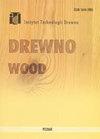孟氏假杉木(pseudosuga menziesii, Mirb.)的鉴定与特性分析德国南部生长的幼木和成木
IF 0.9
4区 农林科学
Q3 MATERIALS SCIENCE, PAPER & WOOD
引用次数: 9
摘要
德国杉木资源的三分之一以上,储存在21岁至59岁的年龄层。随着这种木材越来越多地进入市场,对森林管理者和木材加工者来说,详细了解其木材的解剖结构和特性是非常重要的。本研究对德国南部四个科学管理种植园的20棵树进行了解剖和机械木材分析。所选树木的年龄为42年,其中考虑了不同的生长条件。采用分段线性回归方法对幼木和成材的后期材率、管胞壁厚度、微纤维角度和密度等解剖特征的径向剖面进行了识别。测定了早木、晚木和年轮的宽度以及弯曲弹性模量。变异取决于用于分化的性状,幼木由11 ~ 31个生长年轮组成。辐射量的15%到65%。与成材相比,幼材表现出相应的特征:年轮宽约30%,后期木材比例低34%,管胞壁薄14%,微纤维角大80%,木材重量轻11%,弯曲弹性模量低57%。由于品种的特点是快速生长的树木,成材特征略低于欧洲道格拉斯冷杉的特征。本文章由计算机程序翻译,如有差异,请以英文原文为准。
Identification and characterisation of Douglas-fir (Pseudotsuga menziesii (Mirb.) Franco) juvenile and adult wood grown in Southern Germany
More than one-third of Germany s Douglas-fir resources, stock in age-classes from twenty-one to fifty-nine years. As such timber increasingly enters markets, detailed knowledge of the anatomy and properties of its wood is of importance to forest managers and wood processors. Anatomical and mechanical wood analyses in this study were carried out on twenty trees from four scientifically managed plantations in Southern Germany. The age of the trees selected was forty-two years whereby varying growth conditions were considered. Juvenile and adult woods were identified by segmented linear regression of radial profiles of anatomical characteristics, such as latewood percentage, tracheid wall thickness microfibril angle and density. Additionally, the width of earlywood, latewood and growth rings as well as bending modulus of elasticity were determined. Variance was dependent on the trait used for differentiation, j uvenile wood comprised of an eleven to thirty-one growth rings resp. radial amounts of fifteen to sixty-five percent. When compared to adult wood, juvenile wood showed corresponding features of approximately thirty percent wider growth rings, th irty four percent lower latewood percentage, fourteen percent thinner tracheid walls, and eighty percent larger microfibril angles, eleven percent lighter wood and fifty -seven percent lower bending modulus of elasticity. As the assortment features fast grown trees, adult heartwood characteristics were slightly inferior to the characteristics of European Douglas-fir.
求助全文
通过发布文献求助,成功后即可免费获取论文全文。
去求助
来源期刊

Drewno
MATERIALS SCIENCE, PAPER & WOOD-
CiteScore
1.10
自引率
12.50%
发文量
0
审稿时长
>12 weeks
期刊介绍:
Wood. Research papers. Reports. Announcements" ("Drewno") is an international scientific journal that publishes original results of innovatory basic and applied research concerning technological, technical, economic and ecological issues important for the wood science and forest-based industries, including their environment, and interesting to the international recipients. "Drewno" is an Open Access biannual journal.
Aims and scope:
wood science: anatomy, biology, chemistry, physics
wood mechanical and chemical technology, inter alia, sawmilling, composite wood products, wooden construction, furniture making, wood pulp, paper making
material engineering, biocomposites, nanocomposites
material management
environmental protection, safety of the processes, products and working stations
biotechnology
bioenergy, biofuels
forestry: harvesting and wood quality
wood-based industries economics
The Editorial Board of the journal especially welcomes articles concerning increase in wood resources (wood mobilisation); innovative composites and lignocellulosic materials; new trends in the protection, modification and finishing of wood; biorefining of raw wood material; "green" building; new technologies of wood waste recycling; sustainable development; innovation management; and business networks.
 求助内容:
求助内容: 应助结果提醒方式:
应助结果提醒方式:


